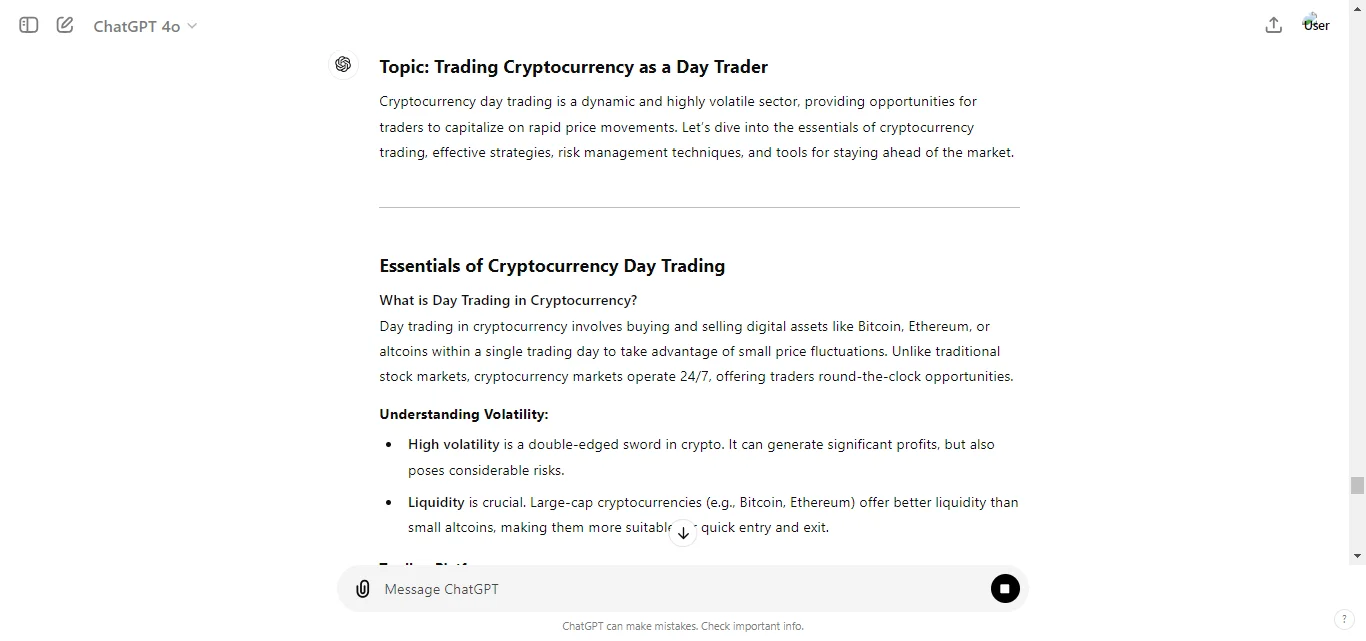Did you know that more than 90% of day traders lose money? It's a tough game, especially when it comes to altcoins. In this article, we’ll dive into the best practices for day trading altcoins, including effective strategies, risk management techniques, and key indicators to watch. Learn how to choose the right altcoins, analyze charts, and set effective stop-loss orders. We’ll also cover the importance of market sentiment, liquidity, and how social media can influence your trading decisions. With insights from DayTradingBusiness, you'll be better equipped to navigate the volatile world of altcoin trading.
What are the best strategies for day trading altcoins?
The best strategies for day trading altcoins include:
1. Research and Select Volatile Coins: Focus on altcoins with high volatility and volume. This increases potential profit opportunities.
2. Use Technical Analysis: Analyze charts, patterns, and indicators like MACD, RSI, and moving averages to make informed decisions.
3. Set Clear Entry and Exit Points: Define your buy and sell levels based on your analysis to avoid emotional trading.
4. Implement Stop-Loss Orders: Protect your capital by setting stop-loss orders to limit losses on trades.
5. Stay Updated on News: Monitor cryptocurrency news and social media to catch market-moving events.
6. Practice Risk Management: Never invest more than you can afford to lose, and diversify your trades.
7. Utilize Trading Bots: Consider using bots for quicker execution and to capitalize on market movements.
8. Keep a Trading Journal: Track your trades, strategies, and outcomes to identify what works best for you.
These strategies can enhance your day trading effectiveness in the altcoin market.
How do I choose the right altcoins for day trading?
To choose the right altcoins for day trading, focus on these key factors:
1. Liquidity: Select altcoins with high trading volumes. This ensures you can enter and exit positions easily.
2. Volatility: Look for coins that exhibit significant price fluctuations. This creates opportunities for profit.
3. Market Trends: Analyze recent price movements and overall market trends. Use technical analysis tools to spot patterns.
4. News and Events: Stay updated on news that could impact prices. Upcoming developments or partnerships can drive volatility.
5. Community and Development: Research the altcoin's community and team. Strong backing often leads to better performance.
6. Risk Management: Define your risk tolerance and set stop-loss orders to protect your investments.
By considering these factors, you can effectively identify altcoins that align with your day trading strategy.
What are the risks associated with day trading altcoins?
Day trading altcoins carries several risks, including high volatility, which can lead to significant losses in a short time. Liquidity issues may prevent you from executing trades at desired prices. Market manipulation is common, making it hard to trust price movements. Emotional decision-making can result in impulsive trades. Regulatory risks exist, as altcoins face varying legal scrutiny. Lastly, lack of information about projects can lead to poor investment choices.
How can I manage risk when day trading altcoins?
To manage risk when day trading altcoins, follow these best practices:
1. Set a Clear Budget: Only invest what you can afford to lose. Stick to your budget to avoid emotional trading.
2. Use Stop-Loss Orders: Set stop-loss orders to automatically sell if an altcoin drops to a certain price, limiting your losses.
3. Diversify Your Portfolio: Don’t put all your funds into one altcoin. Spread your investments across multiple coins to reduce risk.
4. Stay Informed: Keep up with market news and trends. Use social media and news platforms to gauge sentiment and potential volatility.
5. Limit Position Size: Risk only a small percentage of your capital on each trade, typically 1-2%, to manage losses effectively.
6. Practice Technical Analysis: Use charts and indicators to make informed decisions based on price trends rather than emotions.
7. Avoid FOMO: Don’t chase after sudden price spikes. Stick to your trading plan and avoid impulsive decisions.
8. Review Trades Regularly: Analyze your trades to identify what worked and what didn’t. Learn from both your successes and failures.
9. Use a Trading Journal: Document your trades, strategies, and outcomes to track your performance and refine your approach.
Implementing these strategies will help you manage risk effectively while day trading altcoins.
What tools and platforms are best for day trading altcoins?

The best tools and platforms for day trading altcoins include:
1. Binance: Offers a wide range of altcoins, advanced trading features, and low fees.
2. Coinbase Pro: User-friendly interface, great for beginners with a solid selection of altcoins.
3. Kraken: Known for security, it provides margin trading and a good variety of altcoins.
4. KuCoin: Features numerous altcoins and various trading pairs, ideal for diversifying.
5. TradingView: Excellent for charting and technical analysis, helping you track price movements.
6. MetaTrader 4/5: Good for automated trading strategies and in-depth analysis.
Use these platforms to effectively manage trades, analyze market trends, and execute strategies quickly.
How do I analyze altcoin charts for day trading?
To analyze altcoin charts for day trading, start with these steps:
1. Choose the Right Chart: Use candlestick charts for better visualization of price movements.
2. Identify Trends: Look for upward or downward trends using trend lines to gauge market direction.
3. Use Technical Indicators: Apply indicators like Moving Averages, RSI, and MACD to spot entry and exit points.
4. Volume Analysis: Monitor trading volume to confirm price movements; high volume often indicates stronger trends.
5. Support and Resistance Levels: Identify key support and resistance zones to anticipate price reversals or breakouts.
6. Time Frame Selection: Focus on shorter time frames (like 15-min or 1-hour charts) for day trading decisions.
7. News and Events: Stay updated on market news that can impact altcoin prices and volatility.
8. Risk Management: Set stop-loss orders to limit potential losses and define your risk-reward ratio for each trade.
Practice these techniques consistently to improve your day trading skills with altcoins.
What are the key indicators to watch when day trading altcoins?
Key indicators to watch when day trading altcoins include:
1. Volume: High trading volume often signals strong interest and potential price movement.
2. Price Action: Monitor candlestick patterns and trends to identify entry and exit points.
3. Market Sentiment: Check social media and news to gauge trader sentiment and potential market shifts.
4. Technical Indicators: Use tools like RSI, MACD, and Bollinger Bands to assess momentum and volatility.
5. Liquidity: Ensure the altcoin has enough liquidity to enter and exit positions without significant slippage.
6. Support and Resistance Levels: Identify key price levels where the coin tends to reverse or break through.
7. Correlation with Major Coins: Observe how the altcoin moves relative to Bitcoin and Ethereum for broader market trends.
Focus on these indicators to make informed decisions and manage risk effectively.
How can I set effective stop-loss orders in altcoin trading?
To set effective stop-loss orders in altcoin trading, first, determine your risk tolerance. Use a percentage-based approach, like setting a stop-loss at 5-10% below your entry price. Analyze support and resistance levels to place your stop-loss just below significant support to avoid being stopped out by market fluctuations. Consider trailing stop-loss orders to lock in profits while allowing for upward movement. Regularly adjust your stop-loss based on market conditions and volatility. Lastly, avoid setting stop-loss orders too tight, as this can lead to premature exits.
What is the importance of market sentiment in altcoin day trading?
Market sentiment is crucial in altcoin day trading because it drives price movements and trader behavior. Positive sentiment can lead to rapid price increases, while negative sentiment often results in sharp declines. Understanding sentiment helps traders identify trends, make informed decisions, and time their trades effectively. Monitoring social media, news, and trading volumes can provide insights into market mood, allowing traders to anticipate shifts and capitalize on opportunities. Ultimately, aligning trades with prevailing sentiments enhances the chances of profitability in the volatile altcoin market.
How do I develop a day trading plan for altcoins?

To develop a day trading plan for altcoins, follow these steps:
1. Set Clear Goals: Define your profit targets and risk tolerance. Decide how much capital you’re willing to invest.
2. Choose Your Altcoins: Focus on a select few altcoins with high liquidity and volatility. Research their market trends and news.
3. Technical Analysis: Learn to read charts and indicators. Use tools like moving averages, RSI, and support/resistance levels to spot entry and exit points.
4. Create a Trading Strategy: Decide on your trading style—scalping, momentum trading, or breakout strategies. Stick to your plan and avoid emotional decisions.
5. Risk Management: Set stop-loss and take-profit orders to minimize losses and lock in gains. Never risk more than 1-2% of your capital on a single trade.
6. Track Your Trades: Keep a trading journal to record your decisions, outcomes, and emotions. Analyze your performance regularly to improve your strategy.
7. Stay Informed: Follow market news and trends. Join communities or forums to exchange insights and updates about altcoins.
8. Review and Adjust: Periodically reassess your trading plan based on market conditions and your results. Adapt your strategy as needed.
By following these steps, you can create a focused day trading plan tailored for altcoins.
Learn about How to Develop a Futures Day Trading Plan
What timeframes should I focus on for day trading altcoins?
For day trading altcoins, focus on shorter timeframes like 1-minute, 5-minute, and 15-minute charts. These allow you to capture quick price movements and volatility. Monitor key indicators like volume and RSI for better entry and exit points. Adjust your strategy based on market conditions and always set stop-loss orders to manage risk effectively.
How do I track altcoin market trends effectively?
To track altcoin market trends effectively, follow these best practices:
1. Use Reliable Tools: Leverage platforms like CoinMarketCap or CoinGecko for real-time data on prices, market cap, and trading volume.
2. Set Alerts: Use trading apps to set price alerts for specific altcoins, helping you stay on top of market movements.
3. Follow Social Media: Engage with communities on Twitter, Telegram, and Reddit for insights and sentiment analysis.
4. Analyze Charts: Utilize technical analysis tools like TradingView to study price patterns and indicators.
5. Monitor News: Stay updated on crypto news through sources like CoinDesk and CryptoSlate, as announcements can significantly impact prices.
6. Diversify Your Sources: Combine insights from various sources to get a well-rounded view of trends.
7. Track Volume Changes: Pay attention to trading volume spikes, which often precede significant price movements.
By integrating these strategies, you can effectively track and capitalize on altcoin market trends.
What are common mistakes to avoid in altcoin day trading?
1. Ignoring Research: Avoid trading altcoins without understanding their fundamentals and market trends.
2. Overtrading: Don't make excessive trades; stick to a strategy to prevent emotional decisions.
3. Neglecting Stop-Losses: Always set stop-loss orders to limit potential losses.
4. Chasing Losses: Resist the urge to quickly buy back into a losing position; it often leads to bigger losses.
5. Lack of Diversification: Don't put all funds into one altcoin; spread your investments to mitigate risk.
6. Following Hype: Avoid making trades based solely on social media buzz or FOMO; conduct thorough analysis first.
7. Ignoring Fees: Be aware of trading fees that can eat into profits, especially with frequent trades.
8. Emotional Trading: Keep emotions in check; stick to your plan regardless of market fluctuations.
9. Timing the Market: Don’t try to predict short-term price movements; focus on consistent strategies instead.
10. Not Keeping Records: Track your trades to learn from mistakes and refine your strategy over time.
Learn about Common Mistakes in Day Trading Scalping and How to Avoid Them
How do news events impact altcoin day trading?
News events can significantly impact altcoin day trading by causing price volatility. Positive news, like partnerships or technological advancements, can lead to price spikes, while negative news, such as regulatory changes or security breaches, can trigger sharp declines. Day traders should stay updated on news feeds and social media to anticipate market movements. It's crucial to set stop-loss orders to manage risk and capitalize quickly on price shifts. Additionally, understanding the news cycle helps traders decide when to enter or exit positions for maximum profit.
What Are the Best Crypto Markets and Practices for Day Trading Altcoins?
To choose the best crypto markets for day trading altcoins, focus on these best practices:
1. **Liquidity**: Select markets with high trading volumes to ensure quick buy/sell orders.
2. **Volatility**: Look for altcoins that experience significant price fluctuations for profitable trades.
3. **Market Depth**: Ensure there are enough buy and sell orders to minimize price slippage.
4. **Trading Fees**: Opt for exchanges with low transaction fees to maximize profits.
5. **Technical Analysis**: Use charts and indicators to identify entry and exit points.
6. **Regulation and Security**: Choose reputable exchanges with strong security measures.
7. **News and Events**: Stay updated on market news and announcements that could impact altcoin prices.
By following these practices, you can effectively select the best crypto markets for day trading altcoins.
Learn more about: How to Choose the Best Crypto Markets for Day Trading
Learn about How to Choose the Best Crypto Markets for Day Trading
What is the role of liquidity in altcoin day trading?

Liquidity is crucial in altcoin day trading because it determines how easily you can buy or sell a coin without significantly affecting its price. High liquidity means you can execute trades quickly at stable prices, reducing the risk of slippage. In contrast, low liquidity can lead to larger price swings and make it harder to enter or exit positions. Successful day traders often focus on altcoins with high trading volumes to maximize their chances of profit and minimize risk.
How can I use social media to inform my altcoin trading strategies?
Follow these best practices to use social media for your altcoin trading strategies:
1. Join Relevant Groups: Engage in crypto-focused forums and social media groups on platforms like Telegram, Discord, and Reddit to gather insights and trends.
2. Follow Influencers: Identify and follow reputable crypto influencers and analysts on Twitter. Their market predictions and analysis can provide valuable information.
3. Monitor News and Trends: Use social media to stay updated on breaking news that can impact altcoin prices. Tools like Twitter lists can help you track key accounts.
4. Participate in Discussions: Share your insights and ask questions in social media discussions. This can help you gauge market sentiment and discover new trading ideas.
5. Analyze Sentiment: Use tools to measure social media sentiment around specific altcoins. High positive sentiment can indicate a potential price rise.
6. Track Hashtags: Follow relevant hashtags related to altcoins to find trending topics and discussions that might affect your trading decisions.
7. Be Cautious of Hype: While social media can provide opportunities, be wary of hype and FOMO. Always do your own research before making trades.
By integrating these practices into your trading strategy, you can leverage social media effectively for altcoin trading.
Conclusion about Best Practices for Day Trading Altcoins
In summary, successful day trading of altcoins requires a well-rounded approach that includes effective strategies, careful selection of altcoins, and robust risk management. Understanding market sentiment and utilizing the right tools can enhance your trading experience. As you navigate this volatile landscape, remember that continuous learning and adapting your strategies are key. Leverage the insights and resources available through DayTradingBusiness to refine your skills and improve your trading outcomes.
Learn about Best Practices for Selling Day Trading Stocks